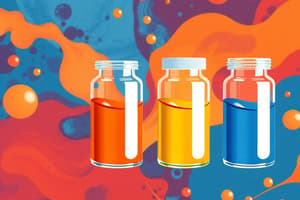Podcast
Questions and Answers
What is one of the primary advantages of liquid dosage forms?
What is one of the primary advantages of liquid dosage forms?
- They have a prolonged shelf life.
- They are more stable than solid forms.
- They can be transported easily.
- The drug is immediately available for absorption. (correct)
Which of the following is a disadvantage of liquid dosage forms?
Which of the following is a disadvantage of liquid dosage forms?
- They can be bulky and difficult to store. (correct)
- They require more accurate dosing.
- They are less effective than solid forms.
- They can be diluted by gastric contents.
What type of water is most commonly used as a solvent in pharmaceutical solutions?
What type of water is most commonly used as a solvent in pharmaceutical solutions?
- Tap Water
- Purified Water BP (correct)
- Distilled Water
- Water for Injection
What is a characteristic of Water for Injection?
What is a characteristic of Water for Injection?
What is an example of a drug that may be better delivered via liquid dosage form due to its irritability?
What is an example of a drug that may be better delivered via liquid dosage form due to its irritability?
What is a disadvantage related to the administration of liquid dosage forms?
What is a disadvantage related to the administration of liquid dosage forms?
Which water type is used specifically for parenteral solutions?
Which water type is used specifically for parenteral solutions?
What feature of water makes it a good solvent for ionic materials?
What feature of water makes it a good solvent for ionic materials?
What limitation regarding liquid dosage forms may complicate treatment protocols?
What limitation regarding liquid dosage forms may complicate treatment protocols?
For which of the following drugs is a specially prepared Water for Injection required due to its gas sensitivity?
For which of the following drugs is a specially prepared Water for Injection required due to its gas sensitivity?
Flashcards
Solution
Solution
A mixture where one substance (solute) is dissolved evenly in another substance (solvent). The solvent is typically present in a larger amount, but exceptions exist like syrup.
Water as a Solvent
Water as a Solvent
Water is the most common solvent used in pharmaceutical solutions due to its compatibility with the body and ability to dissolve many substances. It has a high dielectric constant, which helps dissolve ionizable materials, and lacks selectivity, meaning it can dissolve a wide range of substances.
Purified Water
Purified Water
Purified water is a type of water used in pharmaceutical preparations. It undergoes a process to remove salts, making it suitable for many applications.
Water for Injection
Water for Injection
Signup and view all the flashcards
Specialized Water for Injection
Specialized Water for Injection
Signup and view all the flashcards
Advantages of Liquid Dosage Forms
Advantages of Liquid Dosage Forms
Signup and view all the flashcards
Disadvantages of Liquid Dosage Forms
Disadvantages of Liquid Dosage Forms
Signup and view all the flashcards
Aqueous Solutions
Aqueous Solutions
Signup and view all the flashcards
Glycerin
Glycerin
Signup and view all the flashcards
Suspension
Suspension
Signup and view all the flashcards
Study Notes
Liquid Dosage Forms
- Solutions, the solvent is generally present in a greater amount
- Exceptions exist, like Syrup BP, which contains 66.7% w/w sucrose (solute) in 33.3% w/w water (solvent).
Advantages of Liquid Dosage Forms
- Easier to swallow (for pediatric and geriatric patients)
- Drugs are immediately absorbed (even if the drug is a precipitate, acid, and sufficiently wetted/finely divided.)
- Uniform distribution (e.g. suspensions and emulsions)
- Irritable drugs (e.g. aspirin, potassium chloride) are better as solutions because they are immediately diluted by gastric contents minimizing damage.
Disadvantages of Liquid Dosage Forms
- Liquid dosage forms are bulky (a disadvantage for transport and storage)
- Container destruction is possible
- Stability of the drug and excipients may be affected
- Suitable for microbial growth
- Dosage administration can be inaccurate
- The taste of the drug can be a concern
Choice of Solvent - Aqueous Solutions
- Water is the most widely used solvent due to its physiological compatibility and lack of toxicity
- Water has a high dielectric constant, which aids in the dissolution of ionizable materials.
- Water lacks selectivity as a solvent.
Types of Pharmaceutical Water
-
Purified Water BP: This water is freshly boiled and cooled immediately before use. It contains no salts and can be produced by distillation or deionization.
-
Water for Injection: Used in parenteral (non-oral) solutions. Required to be sterile, pyrogen-free, and salt-free.
- Special types include (but are not limited to):
- CO2-free water for solutions containing phenobarbitone sodium or aminophylline
- O2-free water for solutions containing apomorphine and ergotamine maleate
- Apyrogenic distilled water is prepared by boiling, cooling, and sealing the water in containers while excluding air before sterilizing via autoclaving.
- Special types include (but are not limited to):
Studying That Suits You
Use AI to generate personalized quizzes and flashcards to suit your learning preferences.




